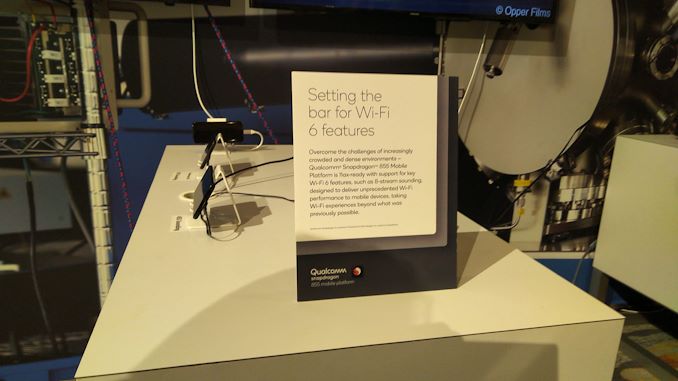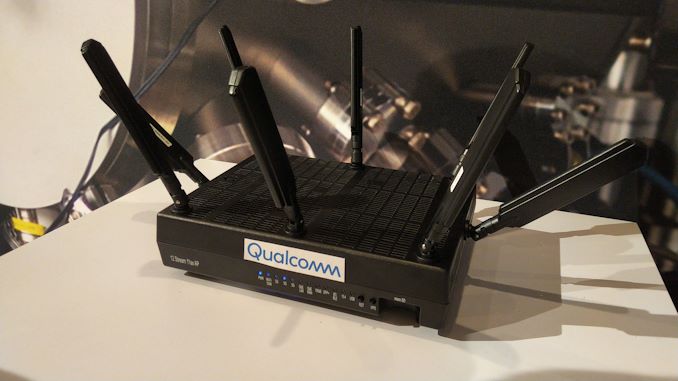Snapdragon 855: 802.11ax-Ready / Wi-Fi 6 Demonstrations
by Ian Cutress on December 11, 2018 4:00 PM EST
While the headline features of the new Snapdragon 855 Mobile Platform might be its 5G connectivity, or the Cat 24 LTE modem, or the new CPU/GPU combination, further down the list is the fact that the S855 chip is also 802.11ax-ready. Under the new branding, this is ‘Wi-Fi 6’. Qualcomm had a demo to show it in action at the Qualcomm Snapdragon Summit.
All In For Wi-Fi 6, the new name for 802.11ax
Without requiring an extra chip, the new Snapdragon 855 SoC will enable the next generation flagships to be 802.11ax ready. This is the update to the popular 802.11ac standard, enabling higher throughput with similar hardware. A big point where 802.11ax wins is in congested networks: when multiple devices require substantial bandwidth, such as 4K/8K video, the new SoC supports 8 spatial streams concurrently, allowing it to perform better in these congested network situations.
The demo Qualcomm had at hand was straightforward – an 802.11ax access point with eight antennas going to three 802.11ax devices and three 802.11ac devices, each doing a form of streaming video with variable bit rates matching the available access point-to-device bandwidth. In this congested network, the 802.11ax devices had higher bit rates and therefore higher quality and fewer dropped frames.
The router being used was a Qualcomm internal design, not for sale, and was interesting in the fact that it had a SFP+ connection from the cabinet into the router in order to provide the data. This likely means that even with multiple devices asking for lots of bandwidth, the backbone of the data delivery still has to be sufficient to support it.
We should point out here that the Snapdragon 855 SoC is 802.11ax-ready, which is different to being fully 802.11ax compliant. The standards are in the final phase of ratification; however Qualcomm had to stop developing the hardware at one point in order to bring it to market on time. As a result, the 855 SoC supports a subset of the 802.11ax standard, and most likely not the whole standard as it will stand.
This won’t be an issue for most things, and some of our regular readers will remember when we had ‘802.11ac-ready’ or ‘802.11n-ready’ routers and devices hit the market before those standards were complete. Nonetheless, it will be interesting to see which smartphone manufacturers list 802.11ax support or 802.11ax-ready support.
For those confused with all the 802 numbering, the Wi-Fi Standards Alliance recently rebranded the whole lot to make it easier. Here’s the conversion table:
| Wi-Fi Names and Performance | ||||||
| Naming | Peak Performance | |||||
| New Name | IEEE Standard |
1x1 Configuration |
2x2 Configuration |
3x3 Configuration |
||
| Wi-Fi 4 | 802.11n | 150 Mbps | 300 Mbps | 450 Mbps | ||
| Wi-Fi 5 | 802.11ac (80 MHz) | 433 Mbps | 867 Mbps | 1.27 Gbps | ||
| 802.11ac (160 MHz) | 867 Mbps | 1.69 Gbps | 2.54 Gbps | |||
| Wi-Fi 6 | 802.11ax | 867 Mbps | 1.69 Gbps | 2.54 Gbps | ||
To add to the mix, 802.11ay, which is the 60 GHz networking which the S855 also supports (an extra chip is required), doesn’t have a number but is called Wi-Gig.












15 Comments
View All Comments
peevee - Tuesday, December 11, 2018 - link
"A big point where 802.11ax wins is in congested networks: when multiple devices require substantial bandwidth, such as 4K/8K video, the new SoC supports 8 spatial streams concurrently, allowing it to perform better in these congested network situations."Is it a congested SINGLE network, or apartment building kind of situation when there are 30+ different networks most of which are ac, n or even g? Wouldn't it be better to able to aggregate up to, say, 8-32 non-consecutive 20MHz channels than having 160MHz channels you will never be able to reserve in real life, even in SFH on 1acre lot?
namechamps - Tuesday, December 11, 2018 - link
You can not. It is why the 160 MHz channel numbers are just nonsense unless you are operating your access point in Siberia. Hell finding a reasonably clear 80 MHz channel isn't guaranteed in high density areas so take those headline number and cut them by 1/2 to 1/4 depending on how conservative you want to be.nismotigerwvu - Tuesday, December 11, 2018 - link
Well that and there's the extra wrinkle that the published values are the PHY rate, which is usually no less than double the actual throughput of a wireless connection even under the best conditions.0ldman79 - Tuesday, December 11, 2018 - link
802.11n and 802.11ac tend to be a little over half vs the previous standards that were half or less.I get 450Mbps peak on an 866Mbps AC connection, which often connects at 780 or 650 under load. It's not unusual at all to get 400Mbps. It is hard as hell to keep max modulations.
The guard interval was cut shorter on N and AC which cut down on the wasted air time pretty decently and general efficiency improvements helped as well. A lot of those gains disappear the instant a legacy client is connected, though it doesn't impact it as badly as connecting an A or G client to an 802.11n AP. AC is better about keeping the wide channel and higher modulation while an A/G client is using air time.
0ldman79 - Tuesday, December 11, 2018 - link
802.11ax can split into sub carriers per 802.11ax client and has contention mechanisms in order to coordinate with other 802.11ax access points.It does correct a *lot* of issues with 802.11, however, until everyone is on 802.11ax as a baseline the issues will persist.
In order for MUMIMO to really work you need at least an 802.11ac wave 2 client.
0ldman79 - Tuesday, December 11, 2018 - link
The frustrating thing is that 802.11n already had the capability of multiple data streams.802.11n 2.4GHz is capable of 600Mbps with 4 chain @ 40MHz channel width but hardly anyone makes 4 chain 802.11n hardware.
Even just using 20MHz channels and getting 300Mbps out of 2.4 would be extremely useful.
802.11ac was already capable of 8 streams, but I've only seen one router that can do that and I can't find consumer level cards with more than 2 chains. I've been looking for a 3x3 or 4x4 AC m.2 card for my laptop ever since I got it. The only 3x3 I've found was an Apple card.
I can find a few for commercial use but they generally won't work in a PC, only in Mikrotik, StarOS, etc, and those are only mini PCIe.
Makaveli - Tuesday, December 11, 2018 - link
This is fantastic.Except you aren't going to get a 4x4 antenna setup on a cell phone like just most AC devices are 2x2 I expect the same even on the Snapdragon 855.
So 1.69Gbps will be max then add abit away from protocol overhead, interference, walls.
Real life transfer rates will be lower after everything is said and done.
GreenReaper - Wednesday, December 12, 2018 - link
Perhaps so - but if you start being limited by your Internet connection, that'd be plenty for most users.0ldman79 - Thursday, December 13, 2018 - link
802.11n can still handle 99% of the Internet connections out there.Honestly the difference between N, AC and AX is channel width for the most part. The higher modulations aren't used unless you have really clear spectrum.
iwod - Wednesday, December 12, 2018 - link
Supporting subset of AX, Still in Draft 4/5 I can't even remember, 1000s of issues remaining,Which is why I said AX might be a mess..... and it is looking like one.
I do wish ALL AX router uses NBase-T, it is time we move to 5Gbps Port instead of 1Gbps.